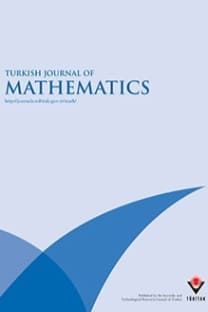Elliptical kinematics of the accretive surface growth
Elliptical kinematics of the accretive surface growth
The stresses within the soft tissue are not constant for some shell surfaces. They vary with position along the mantle edge. In this paper, we show that elliptical geometry is more convenient to describe this type of surface. Thus, we introduce the elliptical kinematics along an initial curve and construct some accretive surfaces with an elliptical cross-section. In fact, these surfaces are not only curves with an elliptical cross-sectional curve, but also the material points of the surface follow an elliptical trajectory during their formation. This situation can be easily explained through elliptical motion and elliptical quaternion algebra. Then, we investigate the relationship between velocity and eccentricity of the surfaces and compare it to the case of circular motion. Furthermore, we visualize some examples to support the theoretical results through the MAPLE program.
___
- [1] Aslan S, Yaylı Y. Canal surfaces with quaternions. Advances in Applied Clifford Algebras 2016; 26: 31-38.
- [2] Boettiger AN, Oster G. Emergent complexity in simple neural systems. Communicative & Integrative Biology 2009; 2 (6): 467-470.
- [3] Davis PJ. The Schwarz Function and its Applications, Carius Monograph 17. Mathematical Association of America, 1974.
- [4] Erlich A, Moulton DE, Goriely A, Chirat R. Morphomechanics and Developmental Constraints in the Evolution of Ammonites Shell Form. Journal of Experimental Zoology Part B: Molecular and Developmental Evolution 2016; 326 (7): 437-450.
- [5] Gök İ. Quaternionic approach of canal surfaces constructed by some new ideas. Advances in Applied Clifford Algebras 2016, doi:10.1007/s00006-016-0703-9 1408.
- [6] Hammer Ø, Bucher H. Models for the morphogenesis of the molluscan shell. An international Journal of Palaentology and Stratigraphy 2005; 38 (2): 111-122.
- [7] Hamilton WR. On quaternions; or on a new system of imagniaries in algebra. The London, Edinburgh, and Dublin Philosophical Magazine and Journal of Science 1844; 25 (3): 489-495.
- [8] Hans M. The Algorithmic Beauty of Sea Shells. Springer, 2009.
- [9] Illert C. Formulation and solution of the classical problem, I Seashell geometry. Nuovo Cimento 1987; 9 (7): 791-814.
- [10] Illert C. Formulation and solution of the classical problem, II Tubular three dimensional surfaces. Nuovo Cimento 1989; 11: 761-780.
- [11] Moseley H. On the Geometrical Forms of Turbinated and Discoid Shells. Philosophical Transactions of the Royal Society of London 1838; 128: 351-370.
- [12] Moulton DE, Goriely A. Surface growth kinematics via local curve evolution. Journal of Mathematical Biology 2014; 68 (1-2): 81-108.
- [13] Özdemir Z. A New Calculus for the Treatment of Rytov’s Law in the Optical Fiber. Optik - International Journal for Light and Electron Optics 2020; 216: 164892.
- [14] Özdemir Z, Cansu G, Yaylı Y. Kinematic modeling of Rytov’s law and electromagnetic curves in the optical fiber based on elliptical quaternion algebra. Optik - International Journal for Light and Electron Optics. Doi:https://dx.doi.org/10.1016/j.ijleo.2021.166334.
- [15] Özdemir M. An Alternative Approach to Elliptical Motion. Advances in Applied Clifford Algebras 2016; 26: 279-304.
- [16] Raup DM, Michelson A. Theoretical Morphology of the Coiled Shell. Science 12, 1965; 147: 1294-1295. doi: 10.1126/science.147.3663.1294.
- [17] Raup DM. The Geometry of Coiling in Gastropods. Proceedings of the National Academy of Sciences of the United States of America 1961; 47 (4): 602-609.
- [18] Shoemake K. Animating rotation with quaternion curves. In: Proceedings of the 12th Annual Conference on Computer Graphics and Interactive Techniques (SIG-GRAPH ’85), vol. 19, pp. 245-254, ACM, New York, NY, USA, 1985.
- [19] Tuğ G, Özdemir Z, Gök İ, Ekmekci FN. Accretive Darboux Growth along a Space Curve. Applied Mathematics and Computation 2018; 316: 516524.
- [20] Tuğ G, Özdemir Z, Aydın SH, Ekmekci FN. Accretive growth kinematics in Minkowski 3-space. International Journal of Geometric Methods in Modern Physics 2017; 14: 1750069.
- ISSN: 1300-0098
- Yayın Aralığı: Yılda 6 Sayı
- Yayıncı: TÜBİTAK
Sayıdaki Diğer Makaleler
On a class of generalized Humbert–Hermite polynomials via generalized Fibonacci polynomials
Mahmood Ahmad PATHAN, Waseem Ahmad KHAN
Yige ZHAO, Yibing SUN, Qiangqiang XIE
Construction of minimal linear codes with few weights from weakly regular plateaued functions
Non-solvable groups all of whose indices are odd-square-free
Roghayeh HAFEZIEH BALAMAN, Sajjad MAHMOOD ROBATI
Second main theorem for meromorphic mappings intersecting moving targets on parabolic manifolds
Clairaut invariant Riemannian maps with Kähler structure
The radii of starlikeness and convexity of the functions including derivatives of Bessel functions
Some notes on crossed semimodules
